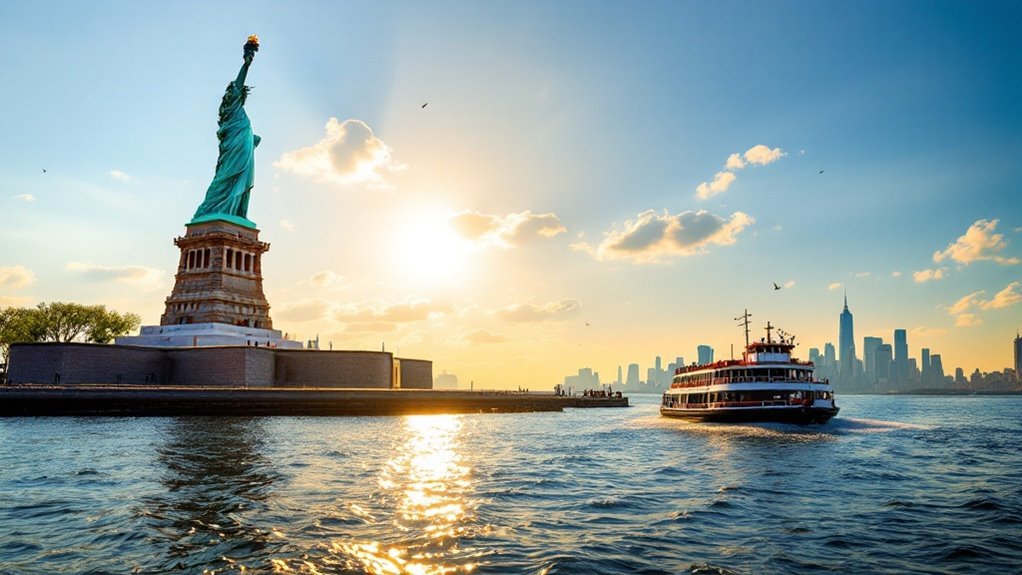Visiting the Statue of Liberty and Ellis Island requires advance planning for the best experience. Tickets should be booked 2-3 months ahead through the official website, especially for crown access. Early morning visits help avoid crowds, and visitors should pack light due to security screenings. Comfortable shoes, water, and weather-appropriate clothing are essential. Ellis Island deserves at least two hours to explore its rich immigration history and exhibits. A deeper journey into these iconic landmarks reveals countless fascinating stories.
Key Takeaways
- Book tickets through the official website 2-3 months in advance, especially for crown access during peak seasons.
- Plan for early morning visits to avoid crowds and allow time for security screening at ferry departure points.
- Bring essential items like comfortable shoes, water, sunscreen, and weather-appropriate clothing for the outdoor experience.
- Verify current ferry schedules and security protocols before visiting to ensure a smooth journey to both landmarks.
- Reserve at least 4-5 hours total to explore both the Statue of Liberty and Ellis Island’s extensive exhibits.
Essential Tips for Planning Your Visit to Lady Liberty
Planning a visit to the Statue of Liberty requires careful preparation and advance booking, especially during peak tourist seasons.
Visitors should purchase tickets through the official website at least 2-3 months in advance to guarantee their preferred date and access level. Crown access tickets are particularly limited and sell out quickly.
Book Statue of Liberty tickets 2-3 months ahead, especially for coveted crown access. Reservations fill quickly at this iconic landmark.
The best time to visit is during early morning hours to avoid crowds and hot afternoon temperatures.
Visitors must pass through airport-style security screening, so carrying minimal belongings is recommended.
Essential items include comfortable walking shoes, water, sunscreen, and a camera. Weather-appropriate clothing is vital, as most areas are outdoors.
Checking the official website for current security protocols, ferry schedules, and any temporary closures guarantees a smooth experience at this iconic landmark.
Making the Most of Your Ellis Island Experience
While the Statue of Liberty stands as America’s iconic symbol of freedom, Ellis Island offers visitors a profound journey through immigration history. The Ellis Island National Museum of Immigration features three floors of exhibits documenting the immigrant experience, from the earliest arrivals to modern times.
Visitors should allocate at least two hours to explore the Registry Room, where millions of immigrants were processed, and examine original artifacts, photographs, and personal stories.
The American Family Immigration History Center allows guests to search passenger records and ship manifests to trace their ancestors’ arrival. For a deeper understanding, the free audio tour provides detailed historical context and first-hand accounts.
The Island’s restored buildings, including the hospital complex, offer additional guided tours that illuminate different aspects of the immigration experience.
FAQ
Why Is the Statue of Liberty Green Instead of Its Original Copper Color?
Towering like a mountain of oxidized pennies, the Statue of Liberty‘s distinctive green color is the result of natural chemical reactions between copper and air.
Over two decades, the statue’s original copper surface underwent a process called patination, where exposure to air and moisture created a protective layer of copper carbonate, known as verdigris.
This green coating actually preserves the underlying copper from further deterioration.
Can You Go Inside the Statue of Liberty’s Torch?
Visitors cannot access the Statue of Liberty’s torch, as it has been closed to the public since 1916.
The closure occurred after the Black Tom explosion, a World War I-era act of sabotage that damaged the statue’s arm.
Although the torch was replaced during renovations in 1984, it remains off-limits due to safety concerns and the narrow, steep access route to reach it.
How Many Immigrants Were Turned Away at Ellis Island?
While many assume Ellis Island rejected large numbers of immigrants, only about 2% of the 12 million people processed there between 1892 and 1954 were denied entry.
Approximately 250,000 people were turned away, primarily due to contagious diseases, mental illness, or criminal records.
Most denials occurred during initial medical screenings, though some immigrants faced rejection after more detailed legal reviews of their cases.
What Happened to Ellis Island During World War II?
During World War II, Ellis Island shifted from an immigration station to a detention and deportation center for enemy aliens.
The facility housed roughly 8,000 German, Italian, and Japanese nationals who were considered suspicious or threatening to national security.
The Coast Guard also used portions of the island as a training facility, and wounded U.S. servicemen were treated in the island’s hospital complex.
Are There Still Unclaimed Items in Ellis Island’s Baggage Room?
One person’s forgotten treasure is another person’s history.
While Ellis Island’s baggage room once held countless immigrant belongings, today there are no unclaimed items remaining from the original processing era.
The room has been restored as part of the Ellis Island Museum, featuring period-appropriate props and replicas to help visitors visualize what the space looked like during its operational years.






